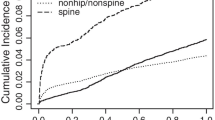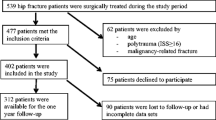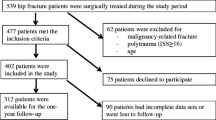Abstract
Introduction
Fragility fractures are a growing worldwide health care problem. Hip fractures have been clearly associated with poor outcomes. Fragility fractures of other bones are common reasons for hospital admission and short-term disability, but specific long-term outcome studies of non-hip fragility fractures are rare. The aim of our trial was to evaluate the 1-year outcomes of non-hip fragility fracture patients.
Methods
This study is a retrospective cohort review of 307 consecutive older inpatient non-hip fracture patients. Patient data for analysis included fracture location, comorbidity prevalence, pre-fracture functional status, osteoporosis treatments and sociodemographic characteristics. The main outcomes evaluated were 1-year mortality and post-fracture functional status.
Results
As compared to the expected mortality, the observed 1-year mortality was increased in the study group (17.6 vs. 12.2 %, P = 0.005). After logistic regression, three variables remained as independent risk factors for 1-year mortality among non-hip fracture patients: malnutrition (OR 3.3, CI 1.5–7.1), Charlson comorbidity index (CCI) (OR 1.3, CI 1.1–1.5) and the Parker Mobility Score (PMS) (OR 0.85, CI 0.74–0.98). CCI and PMS were independent risk factors for a high grade of dependency after 1 year. Management of osteoporosis did not significantly improve after hospitalization due to a non-hip fragility fracture.
Conclusion
The outcomes of older non-hip fracture patients are comparable to the poor outcomes of older hip fracture patients, and appear to be primarily related to comorbidities, pre-fracture function and nutritional status. The low rate of patients on osteoporosis medications likely reflects the insufficient recognition of the importance of osteoporosis assessment and treatment in non-hip fracture patients. Increased clinical and academic attention to non-hip fracture patients is needed.


Similar content being viewed by others
References
Leung F, Blauth M, Bavonratanavech S (2010) Surgery for fragility hip fracture—streamlining the process. Osteoporos Int 21(Suppl 4):519–521
Elliott J, Beringer T, Kee F, Marsh D, Willis C, Stevenson M (2003) Predicting survival after treatment for fracture of the proximal femur and the effect of delays to surgery. J Clin Epidemio 56(8):788–795
Finnes TE, Meyer HE, Falch JA, Medhus AW, Wentzel-Larsen T, Lofthus CM (2013) Secular reduction of excess mortality in hip fracture patients >85 years. BMC Geriatr 13:25. doi:10.1186/1471-2318-13-25
Kammerlander C, Gosch M, Kammerlander-Knauer U, Luger TJ, Blauth M, Roth T (2011) Long-term functional outcome in geriatric hip fracture patients. Arch Orthop Trauma Surg 131(10):1435–1444
Kammerlander C, Roth T, Friedman SM, Suhm N, Luger TJ, Kammerlander-Knauer U et al (2010) Ortho-geriatric service—a literature review comparing different models. Osteoporos Int 21(Suppl 4):637–646
Parkkari J, Kannus P, Niemi S, Pasanen M, Järvinen M, Lüthje P et al (1996) Secular trends in osteoporotic pelvic fractures in Finland: number and incidence of fractures in 1970–1991 and prediction for the future. Calcif Tissue Int 59(2):79–83
Kannus P, Niemi S, Palvanen M, Parkkari J, Pasanen M, Järvinen M et al (2001) Continuously rising problem of osteoporotic knee fractures in elderly women: nationwide statistics in Finland in 1970–1999 and predictions until the year 2030. Bone 29(5):419–423
Kanis JA, Oden A, Johnell O, Jonsson B, de Laet C, Dawson A (2001) The burden of osteoporotic fractures: a method for setting intervention thresholds. Osteoporos Int 12(5):417–427
Court-Brown CM, Caesar B (2006) Epidemiology of adult fractures: a review. Injury 37(8):691–697
Krappinger D, Kammerlander C, Hak DJ, Blauth M (2010) Low-energy osteoporotic pelvic fractures. Arch Orthop Trauma Surg 130(9):1167–1175
Kammerlander C, Gosch M, Blauth M, Lechleitner M, Luger TJ, Roth T (2011) The Tyrolean Geriatric Fracture Center: an orthogeriatric co-management model. Z Gerontol Geriatr 44(6):363–367
Charlson M, Szatrowski TP, Peterson J, Gold J (1994) Validation of a combined comorbidity index. J Clin Epidemiol 47(11):1245–1251
Lachs MS, Feinstein AR, Cooney LM Jr, Drickamer MA, Marottoli RA, Pannill FC et al (1990) A simple procedure for general screening for functional disability in elderly patients. Ann Intern Med 112(9):699–706
Parker MJ, Palmer CR (1993) A new mobility score for predicting mortality after hip fracture. J Bone Joint Surg Br 75(5):797–798
Mahoney FI, Barthel DW (1965) Functional evaluation: the Barthel Index. Md State Med J 14:61–65
Bryant DM, Sanders DW, Coles CP, Petrisor BA, Jeray KJ, Laflamme GY (2009) Selection of outcome measures for patients with hip fracture. J Orthop Trauma 23(6):434–441
Kasner SE (2006) Clinical interpretation and use of stroke scales. Lancet Neurol 5(7):603–612
Liu SK, Munson JC, Bell JE, Zaha RL, Mecchella JN, Tosteson AN et al (2013) Quality of osteoporosis care of older medicare recipients with fragility fractures: 2006 to 2010. J Am Geriatr Soc 61(11):1855–1862
Diamantopoulos AP, Hoff M, Hochberg M, Haugeberg G (2013) Predictors of short- and long-term mortality in males and females with hip fracture—a prospective observational cohort study. PLoS One 8(10):e78169. doi:10.1371/journal.pone.0078169
Abrahamsen B, van Staa T, Ariely R, Olson M, Cooper C (2009) Excess mortality following hip fracture: a systematic epidemiological review. Osteoporos Int 20(10):1633–1650
Fleischman RJ, Adams AL, Hedges JR, Ma OJ, Mullins RJ, Newgard CD (2010) The optimum follow-up period for assessing mortality outcomes in injured older adults. J Am Geriatr Soc 58(10):1843–1849
Hagino T, Ochiai S, Sato E, Watanabe Y, Senga S, Haro H (2011) Prognostic prediction in patients with hip fracture: risk factors predicting difficulties with discharge to own home. J Orthop Traumatol 12(2):77–80
O’Daly BJ, Walsh JC, Quinlan JF, Falk GA, Stapleton R, Quinlan WR et al (2010) Serum albumin and total lymphocyte count as predictors of outcome in hip fractures. Clin Nutr 29(1):89–93
Bell JJ, Bauer JD, Capra S (2013) The malnutrition screening tool versus objective measures to detect malnutrition in hip fracture. J Hum Nutr Diet 26(6):519–526
Kaiser MJ, Bauer JM, Rämsch C, Uter W, Guigoz Y, Cederholm T, Mini Nutritional Assessment International Group et al (2010) Frequency of malnutrition in older adults: a multinational perspective using the mini nutritional assessment. J Am Geriatr Soc 58(9):1734–1738
Hershkovitz A, Kalandariov Z, Hermush V, Weiss R, Brill S (2007) Factors affecting short-term rehabilitation outcomes of disabled elderly patients with proximal hip fracture. Arch Phys Med Rehabil 88(7):916–921
Conflict of interest
None of the authors has conflict of interest regarding the topics discussed in this study.
Author information
Authors and Affiliations
Corresponding author
Rights and permissions
About this article
Cite this article
Gosch, M., Druml, T., Nicholas, J.A. et al. Fragility non-hip fracture patients are at risk. Arch Orthop Trauma Surg 135, 69–77 (2015). https://doi.org/10.1007/s00402-014-2115-4
Received:
Published:
Issue Date:
DOI: https://doi.org/10.1007/s00402-014-2115-4




